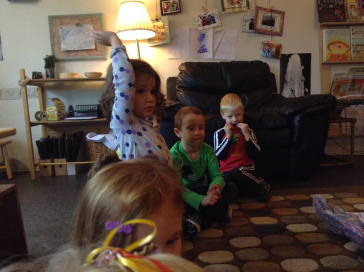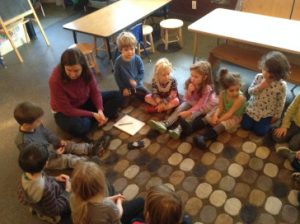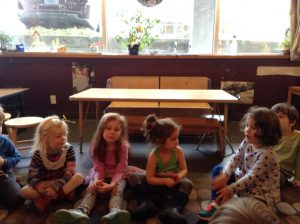
Presents and Prejudice
Earlier this week, for the first time ever, one of my students asked me why I decided to be a teacher. Adults ask me all the time but never a child. It took me by surprise! To me, these moments are one of the biggest reasons I choose to spend my days with young children. They ask the best questions. They make you wonder and they keep you honest. They make you aware of all the things you don’t know. They motivate you to understand the world better. Which is all easy peesey lemon squeezey when you’re talking about why the sky is blue or why we clean up our toys when we’re done using them. It’s a bit different when they want to know how that lady got so fat or why his skin is so dark (is he dirty?) or if that person sleeping outside is dead or if boys can play princesses or if that woman wearing a hijaab is a ninja…I’m guessing you probably have a few of your own classics to include here.
Children can also make declarations that shake you. Declarations that make you angry or embarrassed. That make you want to shut the whole thing down in hopes they will be shocked into never talking like that again.
A couple years ago, I was a new-ish teacher in the field and a brand new teacher at Hilltop. It was my first experience with the expectation of utilizing an anti-bias approach. Chatting with one of my children that first winter, she dropped the bomb that if a child didn’t get presents on Christmas, it was because they were bad. And, all of a sudden, the many faces of children who were marked as ‘bad’ in this child’s world simply because they were going to experience December 25th differently than her popped into my mind. I was stunned into silence, I didn’t know what to do or what to say. Her words made me angry and disappointed. And then I was frustrated with myself because, in that frozen moment, I gave up the chance to bookmark that conversation and come back to it. She moved on and I stayed stuck.
The next year, after much reflection, attending trainings, and talking with my co-teachers, I was so ready I could hardly wait for the kids to start bringing up Santa and presents. Year-ago-Chelsea had assumed she needed all the answers before she could ‘correct’ her students’ prejudiced misunderstandings. Now-Chelsea is a lot more curious about where the info was getting veered off course. Year-ago-Chelsea thought she needed to aggressively tackle prejudiced statements or questions immediately and stomp them into to the ground. Now-Chelsea takes a pause (and a BIG breath) and asks, “Why do you think that?”
As soon as we teachers heard the rumblings, my co-teachers and I talked about how we wanted to respond. In our talks, we realized that we first needed to know where exactly these kids were coming from or else our response could completely miss the mark. What did they think? What were they wondering? What have they already experienced? We planned to center a Morning Meeting around those questions after gathering input from families.
To make sure that these next steps were respectful, inclusive, and with the whole child in mind, I first contacted families with two questions:
- What do you want us to know about your child and family before we go into these conversations
- What are you wondering about your child in this context and/or about bias.
They were generous in their responses which I managed to share back in my eventual documentation. In that initial contact with families, I also shared my experience from the previous year and then tried to put it in some context:
“…While this is the story of a conversation with one particular child, it is a perspective that many children likely hold…This is how our society has constructed the concept of Santa Claus.
However, one thing the Santa lore has NOT represented is that there are so many reasons another child may not wake up to so so many presents that particular morning – they may not celebrate that holiday, the family may not be able to afford gifts, a child may not be with their family to celebrate, and many others. [In the course] of children’s development, they use either/or categories to make sense of the world. They also notice what traits put us into those categories very early on. Research has told us that children begin this process at least at a year old, and, as they grow, that they not only notice differences but they notice the value judgements that society places on those differences. This story about Santa makes it really easy for kids to make the jump that children who don’t receive presents (poor children, children without their families, children who don’t celebrate Christmas, etc) are “bad” kids.”
 Now, don’t get me wrong, the prospect of sitting down with 15 three, four, and five year olds (mostly from affluent, white, two-parent families) to ask them what they knew about Santa Claus was definitely scary. The things that could come up…was I equipped for this?
Now, don’t get me wrong, the prospect of sitting down with 15 three, four, and five year olds (mostly from affluent, white, two-parent families) to ask them what they knew about Santa Claus was definitely scary. The things that could come up…was I equipped for this?
The day came and the conversation was, of course, fascinating, hilarious, frustrating, confusing, eye-opening, and unfinished. We teachers mostly wanted to keep it a fact-finding mission about Santa, Christmas, and Hanukkah since that is what we were hearing from the children and we knowing that many of our families celebrated one or both holidays. We started off with, “Is there anything you want to share that you know about Santa Claus?” and then kept pumping curiosity, warmth, and simple facts and questions into the environment.
Did we solve prejudice that Morning Meeting? No. But we did get an idea of what our kids were thinking about (mostly nice and naughty lists…how do you end up on those and who is in charge?). There were also moments of fact-based correction when we heard misunderstanding arise. We generated ideas for books, activities, and meeting topics to follow up this initial conversation with. Teachers and families had also connected in an honest and vulnerable way which helped us work towards better understanding and bias-awareness all around. And all of these things together means that the children, families, and teachers came away having had the chance to better understand their own thinking and the thinking of others.
Just like the children we spend our days with, I have a hard time imagining a one size fits all approach to these moments. But there are some pieces of equipment that I try to keep on me at all times (because you know they don’t save these comments and questions just for Morning Meeting time!): curiosity, time and space to pause, honesty, simplicity, and forgiveness (mostly for myself and all the ways I bumble through my anti-bias practice). Because, in the end, my children are doing exactly what they are supposed to. They are noticing their world and interpreting it. As a loving adult in their world, my job lies in keeping that interpretation as empowering and accurate as possible.
There are many tools we can embed into our anti-bias curriculum to help. One particular tool is using the visual and verbal messages young children absorb from books and stories. On September 27th, Debbie LeeKeenan, Dr. Caryn Park and Dr. Maggie Beneke discuss ways we can create a community that supports and seeks to include all dimensions of human difference. Join us for – Using Children’s Literature to Provoke Conversations on Challenging Topics. For more information on the Educator Discussion Series, please click here.
2 thoughts on “Presents and Prejudice”
Comments are closed.


Hello,
Was the September 27 discussion recorded and can it be heard after it was over? How might that be possible?
Thank you,
Robin
Hey Robin,
Unfortunately it wasn’t recorded. But we have a list of anti-books and resources we can send you. Let me know! email me at institute@hilltopcc.org and I’ll get that over to you!
Best,
Mike